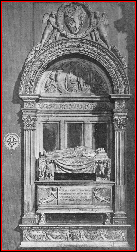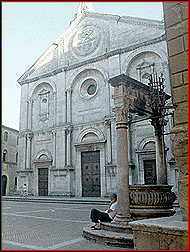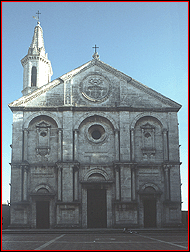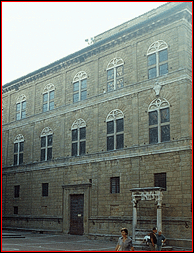Bernardo Rossellino
c. 1409-64
BACKGROUND
Importance
Bernardo Rossellino occupies an important place in the history of both architecture and sculpture in the middle third of the fifteenth century. He worked for at least two popes and was made the Master of the Cathedral Works in Florence in 1461. His tomb for Leonardo Bruni defined a new form of funeral monument.
Origin
Bernardo Rossellino was born in Settignano, a small stone-cutting village near Florence, which was also the home of Desiderio da Settignano. Michelangelo, who was born at a village nearby, was nursed in Settignano.
SCULPTURE
Family Workshop
Bernardo was the head of a family workshop that included his younger brother Antonio. He trained Antonio, who became an important sculptor in his own right.
After his career was well established, Bernardo employed many artists in his workshop. Like other busy masters, he carved only the most important parts of many sculpted works.
Funerary Monuments
Bernardo was especially skilled in integrating sculpture and architecture. His masterpiece, the tomb of Leonardo Bruni, is the first example of a humanist tomb.
Bernardo's tomb was a wall tomb, a type that had come into being in the previous century and consisted of an ensemble of sculpture and a sarcophagus within an architectural frame.
Because of the arch's origin in Roman architecture, it was an ideal form to reflect both Bruni's identity as a humanist and the new Renaissance architectural style of classicism. Both Roman and Christian sources were reflected by such sculpted images as Roman winged genii (guardian spirits) and Christian angels.
Arch-framed wall tombs, which often included an effigy of the deceased lying on a bier above a sarcophagus, became a standard form for tombs over the next century. The Bruni tomb's influence is clear on such tombs as Antonio Rossellino's tomb of the Cardinal of Portugal and Desiderio da Settignano's tomb of Carlo Marsuppini.
ARCHITECTURAL CAREER
Beginnings
Bernardo's training is a matter of speculation because the earliest documents about him date to 1433, when he was already working in Arezzo.
Locations
During his thirty-some year career, Bernardo did much work in Florence and the cities nearby. He also spent periods in other cities like Rome, Pienza, and Perugia.
Architects Who Influenced Bernardo
Bernardo was greatly influenced by the styles of Brunelleschi and Michelozzo, whose work defined the Florentine style of the second quarter of the fifteenth century. He was also influenced by Alberti, who he met in Rome when they were both working for Nicholas V.
Like these architects, Bernardo drew on classical sources and used little ornament.
Work for Popes
Bernardo worked for two popes, Nicholas V and Pius II. It is also possible that he worked for Eugene IV, depending on whether a 1433 reference to an architect named "Bernardo" refers to him.
●Nicholas V. Bernardo worked as Ingenere di Palazzo for Pope Nicholas V in Rome at the Vatican from 1451 until 1453. Two of the projects with which he was associated then are the repair of Old St. Peter's and the enlargement of the choir.
●Pius II. Bernardo's largest and most important architectural work was in Pienza, the renamed birthplace of Pope Pius II, who had strong ideas about the project. Bernardo, who was in charge of the construction of the new piazza and the buildings around it, is generally credited with much of the project's design.
WORKS
♦Enlargement of East End of Old St. Peter's, 1451-53. Pope Nicholas V directed Bernardo to enlarge the east end of Old St. Peter's, which was in need of major repairs and buttressing. The transept was to be lengthened and widened, and a deep choir and a new apse were to be added. A portion of the choir foundations was completed during Nicholas' term, but after his death, the project was dropped.
♦Remodeling of the Rucellai Palace, Florence, 1450s-1464. In the 1450s and early 1460s, Bernardo Rossellino oversaw the remodeling of the Palazzo Rucellai, which included a new façade. Bernardo designed much of the interior, which was an amalgamation of several separate palaces that had been acquired by the Rucellai family over a period of years. A substantial part of one of the old palaces had to be torn down to make room for a courtyard. The design of the original façade is usually attributed to Alberti, but Bernardo has also been credited with it.
♦Piazza Pio II, Pienza, 1459-62. Bernardo worked in Pienza for Pope Pius II on the addition of a new civic piazza with several new or remodeled buildings. The construction of the piazza and major buildings marks the first time in the Renaissance that an ideal scheme of town-planning was actually carried out.
♦Pienza Cathedral, 1459-62, 1459-62. Pienza Cathedral is unusual in its design because the Pope specified that it be based on a Gothic church he had particularly admired when traveling in Austria. The rib-vaulted interior could hardly be more alien to Renaissance design. Although some of the façade's individual members are classical, their arrangement is not.
♦Palazzo Piccolomini, Pienza, 1459-62. Pope Pius II commissioned the Palazzo Piccolomini as a new family residence. In style it is similar to Alberti's Palazzo Rucellai, with which Bernardo had also been associated. The palace's orientation and inclusion of loggias on the rear were planned to provide a view that Pope Pius especially liked.
♦Tomb of Leonardo Bruni, Santa Croce, Florence, c. 1445. Around 1445, Bernardo Rossellino designed, constructed, and carved the sculpture of the tomb of Leonardo Bruni, a highly respected Florentine historian and humanist who had been chancellor of Florence. The tomb's arch-on-pilasters frame became a model for wall tombs during the rest of the century.



 Add Placemark
Add Placemark Go Back
Go Back 








